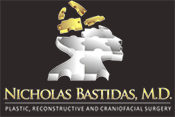Do ear molds hurt babies?
Do ear molds hurt babies? by: Nicholas Bastidas, MD One question i get asked is if ear molds are painful to the babies. Ear molds are designed to be worn comfortably and without any pain or discomfort to your baby. We currently use the ear well system which has a soft, compressible silicone shell that will cradle the ear. Your baby can sleep on their side or can feed lying on the molded ear without it causing any issues. The ear mold itself is attached to the skin by surgical tape and glue and so there are no needles involved or any penetration of the skin. The risks of ear moldings are very low and there is no significant risk of causing any serious injury. While the ear molds are on, your baby can hear totally normal because of the holes that are in the outer plate. In addition, even the inner conchal former piece (that I sometimes use) has holes within it to allow the passage of sound. Babies will sometimes cry when we put the molding on, which is mainly due to the us having to place them on their side and hold their head steady while we apply the ear mold. After the parents pick them up the crying almost immediately stops. In addition, we encourage parents to feed their babies at the same time we are applying the ear well device to make it an even more pleasant situation for the children. Rarely, in some babies who have severe eczema, ear molding may irritate the surrounding skin and precipitate an eczema reaction. In these situations, we may have you remove the ear molding device temporarily and apply a topical steroid cream. This will usually clear the skin condition up with 24-48hrs. Ear molding is really a low risk / high reward procedure for treating deformed infant ears. It is pain-free, requires absolutely no anesthesia and can be worn comfortably for the entire 4 week treatment period. Our experience of over 1200 ear molds allows to get the best results for your baby possible with the lowest risk of complications. Ear molding is a much better alternative to surgery down the road as better outcomes can be obtained by molding he natural cartilage and there is no downtime or recuperation...
Read MoreHow to Correct Ear Shapes Without Surgery
Non-Surgical Ear Molding – The Safer Way to Correct Your Infant’s Ear Shape by Nicholas Bastidas, MD Like most new parents, you want the best for your child. That includes making sure their ears are shaped correctly! Many infants are born with ear deformities, which can be corrected through ear molding within the first three weeks of life. This process is non-invasive, painless, and covered by insurance. What is Infant Ear Molding? Several studies report an increased frequency of infant ear deformities. It consists mainly of prominent and curved ears with sticking edges, folded ears, floppy ears, and pointing ears. Deformities of the outer ear can lead to teasing and psychological impaction of child’s development, and it is, therefore, important to seek treatment as soon as possible. Studies have shown that the severity of ear deformities does not improve if they are not corrected after five to seven days after birth. There are several options for treating ear deformities; the best course of action will vary depending on the individual case. Infant Ear Deformations Ear deformities can range from minor imperfections within the external ear to severe sub-development. This defect can cause concern for newborn parents; if allowed to continue for longer, the child could become self-conscious and need surgical intervention which may be way harder to improve and require cartilage grafting. During pregnancy, many babies develop deformities that can affect their appearance and health. Fortunately, medical advances have made it possible to correct many of these problems with non-surgical methods. One such method is ear molding, which treats congenital ear deformations. Ear molding is a non-surgical technique that uses pressure to reshape the ear. It is often performed on newborns or young infants and is considered to be safe and effective. The procedure is relatively inexpensive and does not require any anesthesia or sedation. In most cases, only one ear needs to be treated. If your child has one of the congenital ear deformities, such as microtia or anotia, they may still be a candidate for ear molding. This relatively simple and low-risk procedure can help your child achieve a more normal appearance. The procedure is typically performed when the child is between two and six weeks old. Ear molding works by gradually reshaping the cartilage of the ear using soft, flexible splints. Over the course of several weeks, the splints gradually reshape the ear into a more normal shape. In some cases, ear molding may need to be combined with other procedures, such as bone conduction hearing devices, to achieve the best results. Prominent Ear (Protruding Ears) Prominent ears (commonly known as protruding ears) are a common ear deformity among infants. The condition is usually genetic, affecting both boys and girls equally. In most cases, the protrusion is mild, and it can be easily corrected with surgery. However, the condition is more severe in some cases, resulting in hearing loss or balance problems. Early intervention is important for preventing these complications. Folded Ear (Lop Ear) When an infant is born, the cartilage in their ears is soft and flexible. As a result, their earlobes may appear flattened or folded. This condition, known as folded ear (or lop ear), is quite common and usually resolves itself within the first few weeks of life. In some cases, however, the fold may persist into childhood or adulthood. While folded ear does not generally cause any health problems, some people may want to correct it for cosmetic reasons. Constricted Ear When the cartilage in the ear is deformed during fetal development, it can result in a constricted ear condition. This condition...
Read MoreIs Ear Molding Permanent?
Is Ear Molding Permanent? by Nicholas Bastidas, MD The short answer is YES. When started soon after your baby is born, ear molding can achieve permanent correction of your child’s ear deformity. Right after birth, your babies ear cartilage is very soft and therefore malleable. It is thought that the circulating estrogen from their mother allows the cartilage to remain pliable. The same forces can can deform their ear in utero, can also be manipulated to permanently correct the shape of the ear after birth. The most important factors I have found are: 1) Time of ear molding initiation Ear molding should ideally be started soon after 1 week of life and before 3 weeks of life. There is some auto-correction during the first week and so i often counsel to wait at least 5 days before beginning treatment. Prominent ear requires early intervention especially and longer treatment due to what i perceive as the inherent weakness and lack of rigidity of the cartilage. Cryptotia and Conchal crus deformities can sometimes be treated even several months later with success. Lop ear, lidding, constricted ear and cup ear should be treated within 1-3 weeks for the optimal effects. 2 ) Length of treatment For most ear deformities i suggest 4 weeks of treatment to be optimal and sufficient for permanent correction. Prominent ear needs at least 4-6 week of treatment given the high risk of relapse. Some conchal crus deformities can be treated in only 3 weeks. When babies present late (>3-4 weeks) to my clinic, i may due 5-8 weeks of treatment depending on the severity of the deformity. 3) Consistency of treatment Ear molding only works if the molds are maintained in place during the entire length of treatment. In our clinic we modify the molds and apply extra superficial tape to help ensure the ear molds do not shift during feeding or sleeping. If the molds are dislodged, we have our parents call and guide them through placing temporary fitting until the permanent ear mold can be replaced. To sum it all up – ear molding when done correctly and in the right setting is permanent and a better alternative to doing surgery in the future. We have performed over 1000 ear deformity corrections and our experience has helped us create the best strategic plan or your baby. Other then an occasional prominent ear relapse, we have not seen the need for any our ear molded infants to require any further correction in the future. If you have any questions – please contact us or an...
Read MoreWill Folded Ears Correct on their Own?
Will Folded Ears Correct on their Own? By Nicholas Bastidas, MD I often get asked from new moms and dads if folded or funny shaped ears will correct on their own. The answer of course depends on how long its been that way as well as if the ear is missing parts of the cartilage that will prevent it from correcting without help. The general rule of thumb is that deformed (not malformed) ears will correct within the first 5-7 days of life. In fact when my daughter was born she had elf looking ears and i was thinking i would have to mold her ears using an Earwell device. 2 days later the ears had fully self-corrected and i didn’t need to do anything. For this reason i always tell patients to wait at least 5 days before coming in for a consultation. After five to seven days of life however, if the ears have not improved on their own 85-90% will likely stay the same way for the rest of your child’s life. This creates a sweet spot for intervention which is 1-3 weeks and significant time limitation. I often see parents who present several months later and the treatment is not as efficacious. The old teaching was to just ignore misshapen ears, thinking that they will likely get better without intervention. Unfortunately, this is usually not the case and ears should be molded as close to 1 week after birth ideally if so desired. Some parents use hats and try to push the ears back to correct the deformity and we do not discourage that. The ear well device that we use has been designed to correct misshapen ears and offers vectors of molding that a simple hat or tape can not mimic. A good indicator to predict if ears will correct may be to see if there is a family history of folded or funny looking ears. A sibling or a parent perhaps. There seems to be some genetic link to the quality of the cartilage and the shape of the ears that newborn may possess. It is important to distinguish a deformation (misshapen ear due to force or compression in the womb) from a malformation (missing anatomic parts of the ear cartilage). Usually malformed ears are smaller (microtia) and may even be associated with ear tags (branchial remnants). A small ear canal may also be present in a malformed or microtia type ear. Ear molding will not fully correct a microtia problem and only ear reconstruction will serve that purpose. Please feel free to send us a picture if you are unsure or have any questions. To sum it all up, ears may correct on their own up 1 week after birth. If they haven’t please consider making an appointment soon after to do ear molding if you desire correction for your...
Read MoreWhat are the risks of ear molding?
What are the risks of ear molding? By Nicholas Bastidas, MD Ear molding is a powerful, non surgical way to correct the shape and position of a newborns ears and one of my personal favorite things to do in pediatric plastic surgery. One of the more common questions patients ask me is what are the risks or downsides associated with ear molding. Any procedure that is done has inherent risks and fortunately ear molding does not have many significant ones and nothing dangerous to your child. Risk #1: Risk of Undercorrection For ear molding to be most successful it should be started early (ideally less then 3 weeks). I usually give at least 1 week for ear deformities to correct on their own before intervening and i prefer to start as close to it as possible. Most ear deformities can be corrected within only 4 weeks of treatment. Usually I have patients come back in 2 weeks for me to reposition the Risk #2: Risk of Skin Irritation I find that spit up can cause a skin irritation when left uncleaned in the areas of the tape. We always send our families home with extra tape and instructions on how to replace the tape. We purposely use a hypoallergenic tape to reduce any potential allergy to the adhesive. Sometimes also we may notice that the pressure from the mold can cause an ulceration (blister). Removing the pressure and using a topical ointment will remedy this problem without any permanent problems. If your baby is more irritable then usual this may be due to skin irritation and we can assess this in the office. Skin irritation (inflammation) may resemble an infection but we can assure you that infection is incredibly rare and almost never seen in ear molding. Risk #3: Risk of Relapse Relapse or return to original deformity is a risk of ear molding. I decrease this risk by starting intervention ideally at less then 3 weeks of life. In addition, we secure the ear molding using extra tape and adhesive to keep the molds in place for the entire treatment plan. Some difficult deformities may require additional time and we may elect to continue molding another 1-2 weeks. One week after completing ear molding if you haven’t seen relapse then the ear will likely permanently maintain its new shape. Risk #4: Risk of an Ugly Haircut Unfortunately, there is a 100% risk of this happening as we need to shave about 1” around the ears to be treated. Fortunately, the hair will grow back within a couple months and you can tell your friends and family that your baby is starting a new hair trend ;). We have to shave this area of hair or else the molding will not stay stuck to the...
Read More



